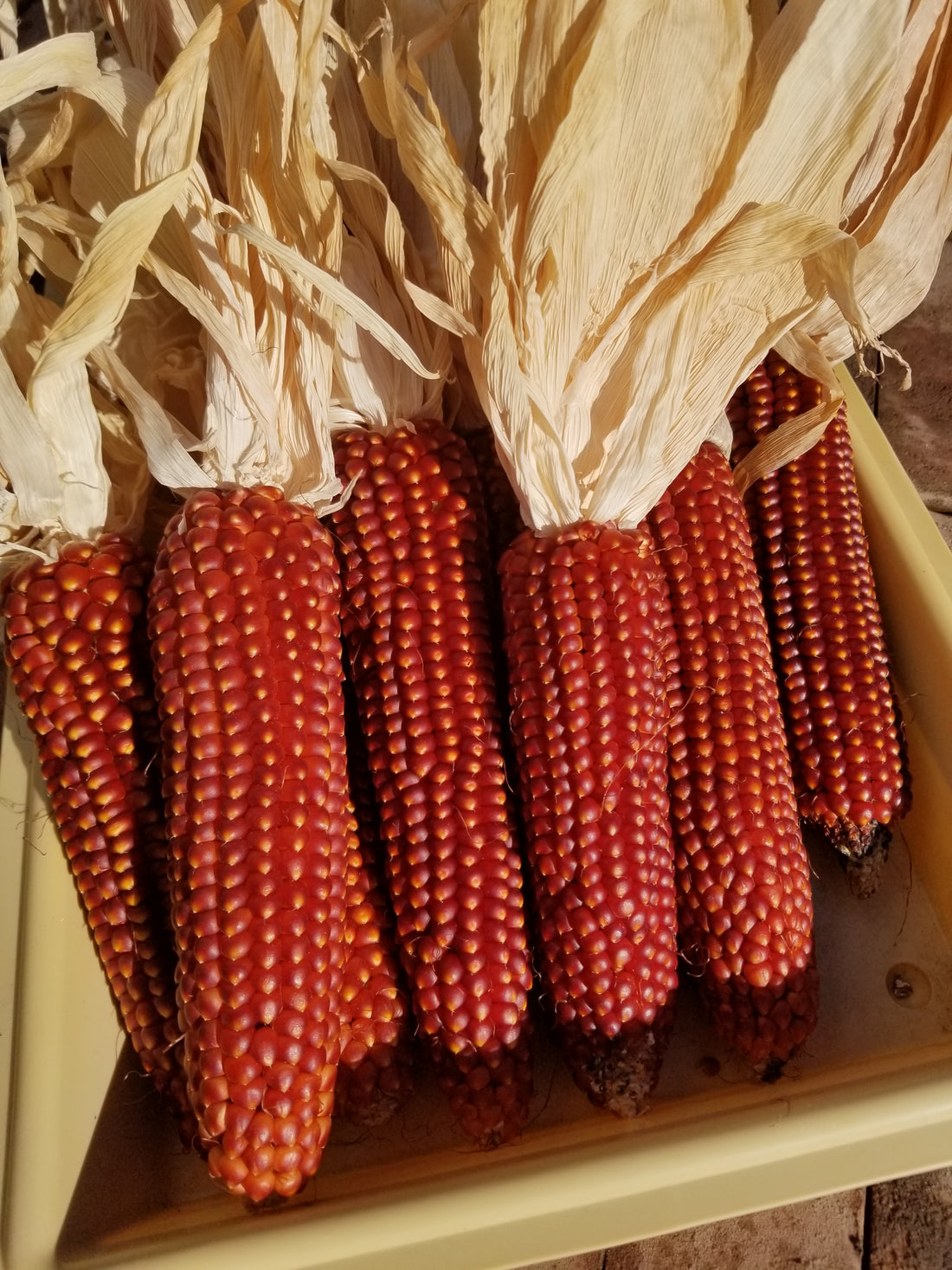
Refining our Floriani Red Flint Corn
Over the years, in addition to growing Floriani Red Flint Corn for eating and seed stock, I am traveling on a multi-year journey to refine the seed line. For selling, I hand select the ears that go into the mix. I want to improve the percentage that meet my requirements.
Searching the internet, seems there are two memes for Floriani:
- One with "RED" in the name, like this:
I am working on this "red" strain.
- One without "red" that appears a shade of burned orange, like this:
My first priority is to breed out the traces of 'dent'. This is a flint corn, there should be no 'denting'. This likely slipped in from field corn contamination.
To support this task, back in 2019, I selected 100 from 700 ears and assigned them a serial number for tracking. Each of these centurions will be evaluated by planting our as many seeds as I have space. Ideally, they would be planted in blocks of at least 50 plants from each mother cob. Since, pollen settles within several meters (~12 ft), the cobs in the center of each mini-patch would be mostly pollinated by it's siblings. Alas, I haven't the space (or labor) for 2500 plants.
.
The goal of this technique to is evaluate the 'children' of each mother corn to decide if it consistently carries the desired traits. I believe this technique is what was referred to as cob-to-row and first used around the 1890's. In discussions with a professional corn breeder, he said I could trade time for space. This fall, I can sift through the harvest to decide which mother corn serial numbers make the cut and which don't. At this point, I'll have enough corn (say 5 to 15 ears) to grind cornmeal for taste testing for each 'winner'. I haven't decided if corn bread, pancakes or polenta should be the tasting method.
Then, next Spring start again with the rest of the seeds in larger blocks from each winner. The following year, begin to cross (mix) winners with winners. Of course to narrow down the competition to reach the tasting test (who wants to chew on 100 different seed samples), I need a mathematical method to track the physical traits of interest. Each ear was evaluated to create a score:
- Judge the 'red', 5 being the color I want and 1 being dark maroon
- Judge the 'yellow' 5 being very little yellow, 1 too much yellow
- Judge the 'pointiness', 5 being pointed with a sharp tail, 1 being rounded
- Judge the 'dentiness', 5 being no dent, 1 is like dent corn
- Measure the cob length
For each of the first 4 categories, I laid out samples and took pictures of 5, 4, 3, 2 and 1 samples. A prize winning ear would be a 5555 8" with a less desirable being ear being 4455 5" and 4444 4" becoming corn meal.

My first priority is to breed out the traces of 'dent'. This is a flint corn, there should be no 'denting'. This likely slipped in from field corn contamination.
I also sorted through seed samples received through seed swaps to obtain the desired colors, long points and no dents. Of course for those, I have no idea of cob length.
Next topics:
- grouping by size and number of 5's
- orientation relative to the wind
- harvest plans

A cold wet spring made for a poor corn crop in 2019.
In 2020, I took samples from the seeds used in 2019 and formed 3 groups:
- 55XX--essentially prime examples of the color I wanted
- XX55--essentially prime examples of the shape I wanted
- 3 or 4 5's--over all good looking samples
I also made 3 more sets
- Samples from what I harvested in 2018
- Samples from what I harvested in 2019
- Samples from seed swaps
Those 6 groups were planted in two plots, let's call them East and West. During harvest, each year had to be put into the correct address of the 12 choices. That was way more work than I would have thought! The cobs with seeds were weighed, as well as the resulting seeds and empty cobs... statistics galore.
However, manually harvesting each ear from 12 possible categories was a logistically large amount of work. I did it, however, will reduce the scale in the future.
In summary, the seeds of 2018 recreated the original mix. Nothing stunning happened in the 2019 or swap group. There were some nice specimens in the 3 to 4 5's, but as a group, the results were not consistent. The winners were the 55XX and XX55. Each group had the tone indicated by the score: Color for 55XX and Point for XX55. As expected, east vs west plot had no impact and it showed me how much variation in yield is typical. I kept samples of the first three groupings.
As I shelled cobs one at a time by hand.. the two ends went into the 'eat' bin and the rest went into the seed bin. For especially noteworthy ears, I left a bit like this:
When I was finishing with the Floriani, my last task was to take all of these samples and sort them into three bins:
- Red
- Red and Pointy
- Pointy
When I look at photos from 2018, I can see that I have made progress in removing the yellow. It will be interesting to see what a few more years of selection will do.
In 2021, I planted and harvested the groupings as
- Pmix--a sample pulled from what we sell
- XX's--a mixture of 2019/2020's that had scored well in past years
- Red--selected to be my ideal red color
- Pointy--selected to be my ideal pointiness
- Pointy Red--selected to be the best



